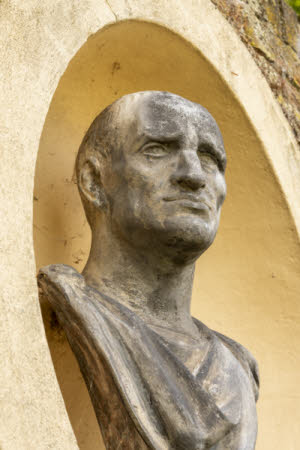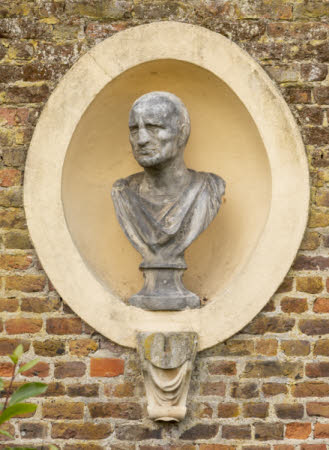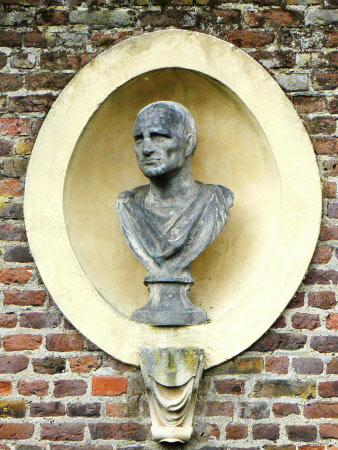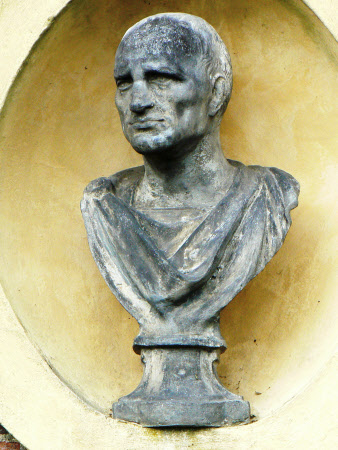Bust of a Roman, perhaps Scipio Africanus
workshop of John Besnier (fl.1681)
Category
Art / Sculpture
Date
c. 1670 - 1672
Materials
Lead, Sandstone
Measurements
775 mm (H)430 mm (W)
Place of origin
London
Order this imageCollection
Ham House, Surrey
NT 1140369
Summary
A lead portrait bust of a Roman, possibly the Roman general Cornelius Scipio Africanus, wearing armour and a cloak. One of thirty-eight lead busts made for the garden walls of Ham House in 1671-72, perhaps in the workshop of John Besnier, thirty-six of which survive in niches on the walls and on the north façade of the house.
Full description
A lead portrait bust of a Roman dressed in armour, with the top of his corselet visible, and over it a cloak, fastened at the shoulder with a circular brooch. Mounted on a plinth, and placed on a sandstone console carved with a pattern of drapery. The portrait shows a strong and determined individual and may represent Publius Cornelius Scipio Africanus (236/235-183 B.C.), the Roman general and statesman celebrated for his victories against Hannibal and the forces of Carthage in the Second Punic War (201-201 B.C.). A portrait of Scipio Africanus in Johannes Faber’s compendium of portraits of ancient heroes Illustrium Imagines, published in Antwerp in 1606, shows a similar determined and thick-set appearance. A similar portrait was also published in 1638, as part of Peter Paul Rubens’s series of twelve prints depicting famous Greek and Roman men. There are two busts of this model at Ham, the other NT 1140334. They are part of a series of thirty-six lead busts displayed in oval niches in the garden walls and on the north façade of Ham House, probably installed in 1671-72, and recorded in the 1679 inventory of Ham House. The entire series was probably arranged in its present positions along the garden walls and on the north front of Ham House by the 6th Earl of Dysart, as part of improvements undertaken between 1798 and 1803. The busts may well, like other sculpture at Ham House, have been made in the workshops of the Besnier family, perhaps by John Besnier, who received a commission for lead statuary from the Duke of Ormonde in 1681. For a fuller discussion of the garden wall busts and their history and attribution, see NT 1140333. Jeremy Warren January 2022
Provenance
Probably made and installed in 1671-72, to the commission of John Maitland and Elizabeth Murray, 1st Duke and Duchess of Lauderdale. Thence by descent,until acquired in 1948 by HM Government when Sir Lyonel, 4th Bt (1854 – 1952) and Sir Cecil Tollemache, 5th Bt (1886 – 1969) presented Ham House to the National Trust. Entrusted to the care of the Victoria & Albert Museum until 1990, when returned to the care of the National Trust, to which ownership was transferred in 2002.
Makers and roles
workshop of John Besnier (fl.1681), sculptor
References
Avery 2013: Charles Avery, ‘Seventeenth-century Sculpture at Ham House’ in Christopher Rowell, ed., Ham House. 400 Years of History, New Haven/London 2013, pp. 158-77., pp. 172-76



